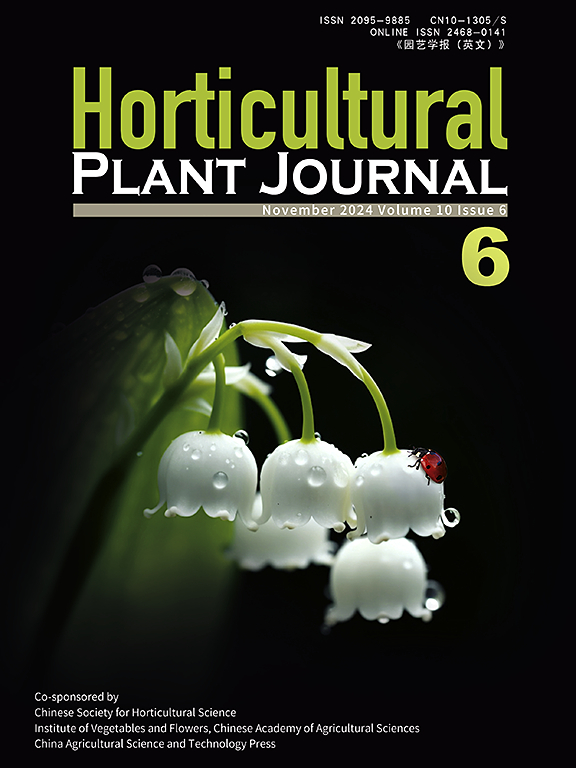柑桔外质体pH对柑桔黄单胞菌的影响。柑橘入侵和溃烂形成
IF 6.2
1区 农林科学
Q1 HORTICULTURE
引用次数: 0
摘要
pH值在植物病原体的生长和定植以及它们在宿主内引起的症状的发生和进展中起着关键作用。植物可以迅速改变它们的外胞体pH值(pHapo)来保护自己免受感染。然而,病原体也可以改变周围环境的pH值来促进自身的生长。柑橘溃疡病是柑橘黄单胞菌引起的一种严重的植物病害。citri (Xcc)。这种革兰氏阴性好氧棒通常在pH为7的Luria-Bertani (LB)培养基中培养。然而,对于Xcc侵染和定植后培养基中pH值的变化,以及叶片外质体中pH值的变化,我们所知甚少。此外,xcc抗性和xcc敏感基因型柑橘叶片外质体pH值的差异也未知。在这里,Xcc在初始pH为6-8的LB液体培养基中生长良好,病原菌将培养基pH改变为6.8±0.4。Xcc生长在pH 5时下降,在pH 3、4、9和10时为零。对易感甜橙接种Xcc后,其溃疡病症状在pH值3、4和10时受到抑制,但在pH值5-9范围内无差异。正如预期的那样,在所有接种pH值下,耐药香橼C-05都没有出现溃疡病症状。对于两种基因型,Xcc仅在pH 5-8接种体的叶片中生长良好。接种4 d (4 dpi)后,抗性香橼C-05叶片pHapo由5.6迅速下降到4.4。2 dpi时,易感甜橙的pHapo由5.6迅速增加到6.7,Xcc迅速增长,出现溃烂症状。fusicoccin (FC)激活质膜(PM) H+- atp酶可使甜橙叶片外质体酸化,并上调致病相关基因(PRs)。因此,Xcc的定植和溃疡病的发展受到抑制。本研究结果揭示了外胞体酸化与Citron C-05对Xcc感染的抗性有关,并为pHapo调控与植物对细菌病原体入侵的抗性之间的关系提供了新的思路。本文章由计算机程序翻译,如有差异,请以英文原文为准。
The influences of citrus apoplast pH on Xanthomonas citri subsp. citri invasion and canker formation
The pH plays a key role in the growth and colonization of plant pathogens as well as the onset and progression of the symptoms they cause within the host. Plants may quickly alter their apoplastic pH (pHapo ) to protect themselves against infection. However, pathogens can also alter the pH of their ambient environment to promote their own growth. Citrus canker is a serious plant disease caused by Xanthomonas citri subsp. citri (Xcc ). This Gram-negative aerobic rod is usually cultured in Luria–Bertani (LB) medium at pH 7. However, little is known about the changes in pH both in this medium as Xcc grows and in the leaf apoplast in response to Xcc infection and colonization. Moreover, the differences in leaf apoplast pH between Xcc -resistant and Xcc -susceptible citrus genotypes are also unknown. Here, Xcc grew well in liquid LB medium at initial pH 6–8 and the pathogen altered the medium pH to 6.8 ± 0.4. Xcc growth declined at pH 5 and was zero at pH 3, 4, 9, and 10. In susceptible sweet orange infected with Xcc inoculum, canker symptoms were inhibited at pH 3, 4, and 10 but did not differ in the range of pH 5–9. As expected, canker symptoms were absent at all inoculum pH in the resistant Citron C-05. For both genotypes, Xcc only grew well in the leaves exposed to pH 5–8 inoculums. At four days post-inoculation (4 dpi), the foliar pHapo of resistant Citron C-05 had rapidly declined from 5.6 to 4.4. At 2 dpi, the pHapo of susceptible sweet orange had rapidly increased from 5.6 to 6.7, Xcc grew quickly, and canker symptoms appeared. Plasma membrane (PM) H+ -ATPase activation with fusicoccin (FC) acidified the apoplast and upregulated the pathogenesis-related genes (PRs ) in the sweet orange leaves. Hence, Xcc colonization and canker development were inhibited. The results of this study revealed that apoplastic acidification is implicated in the resistance of Citron C-05 to Xcc infection and provided insight into the association between pHapo regulation and resistance to bacterial pathogen invasion in plants.
求助全文
通过发布文献求助,成功后即可免费获取论文全文。
去求助
来源期刊

Horticultural Plant Journal
Environmental Science-Ecology
CiteScore
9.60
自引率
14.00%
发文量
293
审稿时长
33 weeks
期刊介绍:
Horticultural Plant Journal (HPJ) is an OPEN ACCESS international journal. HPJ publishes research related to all horticultural plants, including fruits, vegetables, ornamental plants, tea plants, and medicinal plants, etc. The journal covers all aspects of horticultural crop sciences, including germplasm resources, genetics and breeding, tillage and cultivation, physiology and biochemistry, ecology, genomics, biotechnology, plant protection, postharvest processing, etc. Article types include Original research papers, Reviews, and Short communications.
 求助内容:
求助内容: 应助结果提醒方式:
应助结果提醒方式:


